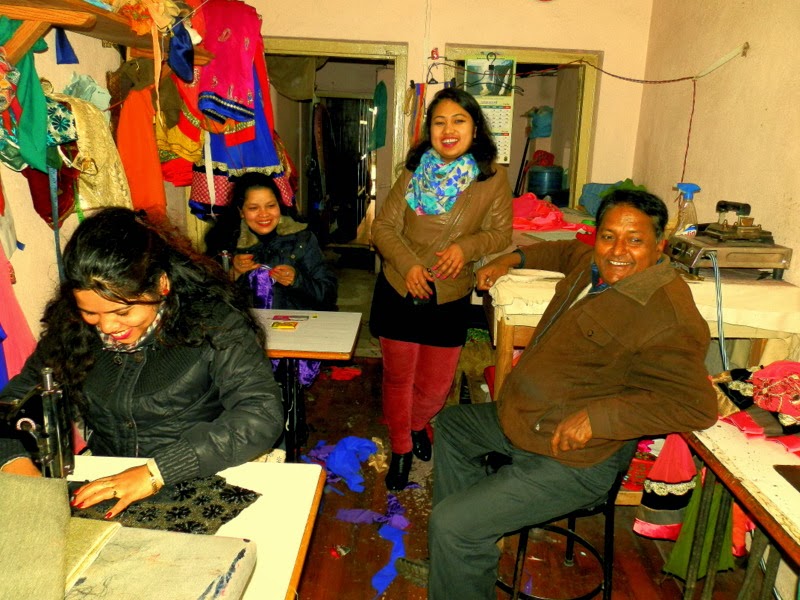a) I get to say things like "I need a sari blouse" and really mean it.
b) If this notion just crosses my mind a few hours before the blouse is needed, I can get one made from scratch -- all within two hours, and in my own neighborhood.
Okay, I know I should be saying that I love where I live because of the rich multicultural tapestry, the opportunity to make a difference for the poor and oppressed, and the exciting entrepreneurial spirit that poses a feisty challenge to the globalized status quo. All of which is true. But it's also weirdly cool to wake up and realize, "Ohmigod it's cold, and I'm going to a wedding reception tonight, and so of course I'll wear a sari, but I don't have a long-sleeved sari blouse! Oh no, whatever shall I do?!?"
The Western equivalent of "I need a sari blouse" might be "I need a little black dress." But, see, little black dresses are boring. They're the definition of "meh." Coco Chanel killed fashion in the West. Well, Coco Chanel plus the fact that truly cool things like beads and embroidery cost a lot of money, plus we're really a bunch of Puritans inside and so it was such a relief to the Western mind when it turned out that color and ornamentation weren't okay anymore.
Watch out. This may turn into a fashion blog.
 |
| What I suddenly realized I'd end up wearing inside at night, with no heat. Brrrrr. |
Oh, I could get away with a salwar kameez. Heck, I'm a Westerner, so I could get away with jeans and a down jacket; yeah, I'm married to a Nepali and get brownie points for getting the culture "right," but they'd cut me slack. Still, what fun is that?
So off I went off to see which of the tailors and seamstresses in the 'hood could make a purple velvet blouse in a few hours. Notice that I said which of them, because there are many tailors and seamstresses within a 10-minute walk. That is because Kathmandu is fantastic. Oh, it's chaotic and congested, but it's got real neighborhoods, and they're built (or rather, grow organically) to make it easy to shop on foot for pretty much everything. Of course, this is because most people don't have cars, which has its obvious negative side, but it's great for walkability and small business. This is still a town for people, and not for the chain stores, strip malls, and highways that kill small business and turn communities into sterile wastelands that only corporations and Hal the 2001 Computer could love.
 |
| If you see a mannequin, you know it'll cost. |
Finally, I found a boutique -- which means "has glass windows, mannequins and charges more" -- that had purple velvet in stock and could make a blouse within two hours, starting now. It's one of thousands of woman-owned tailoring and clothing shops that provide people with a living (many of them other women who can work on fairly flexible schedules) while also, as it happens, keeping much of the money in Nepal and preserving a South Asian fashion culture that is a rich alternative to mass-produced global dullness. I'm a big believer in "small is beautiful," and in the case of small shops and boutiques, it's quite literally beautiful.
The six people who make a living here include this guy, the goldwork embroidery master. It was incredible to watch him work. His name is Lal Mohammed, and he is originally from Janakpur but learned his trade 20 years ago in Calcutta. The gold-colored metal thread seems to spill from his hands like magic.
 |
| The velvet for the blouse is stretched on a frame |
 |
| It takes a week to make a blouse like this. Goldwork involves a needle-like tool that seem to catch the fabric, but I'll be darned if I could figure it out by watching. |
 |
| These will become the neck trim. The term "goldwork" doesn't necessarily involve real gold, but metal threads that look like gold or silver. |
 |
| Lal Mohammed's bead work, or a little black dress? Oh puhleez. It's not even a contest. |
Well, I had neither the time nor the budget for one of Lal Mohammed's masterpieces, but in two hours, I had a warm, well-lined blouse in purple velvet with silver trim. With my sari and high-performance thermal underwear a la snow camping, I was all set for a wedding party in the Himalayan winter.
 |
| I'll put up a better pic if I find one, but for now, here's a mirror selfie with purple two-hour sari blouse. I've also got two layers of thermal underwear on. Otherwise I'd look svelte, of course. |


